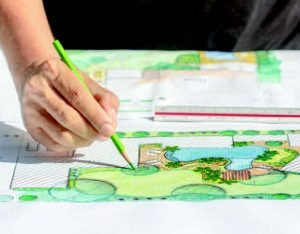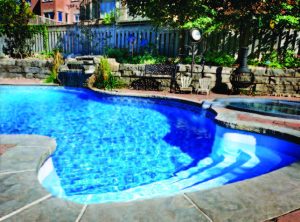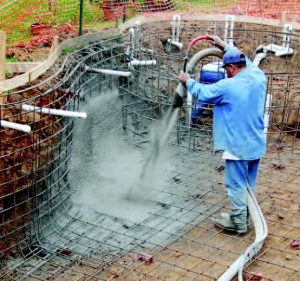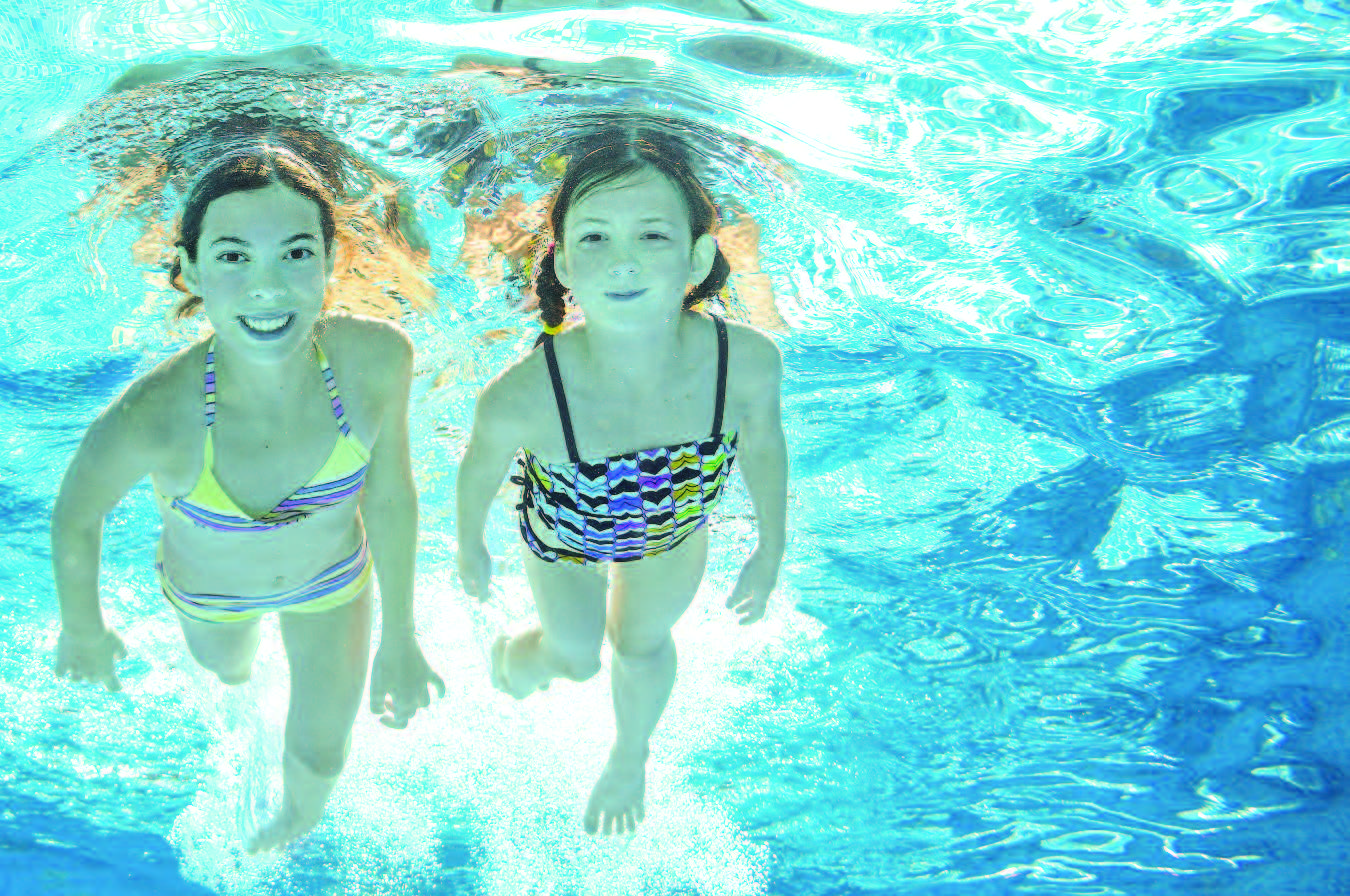How to get your dream pool…without getting in over your head.
By Caleb MacLean
March is swimming pool season. As winter recedes, our thoughts turn to summer fun. This is when New Jersey pool-builders get busy, pressured to complete their projects by Memorial Day. Or sooner. If you’re just now getting ready to pull the trigger on a pool project, might I make a suggestion: Rather than rushing into things, consider taking the summer to educate yourself. Ask friends and co-workers what they would change about their pool, and what they wouldn’t. Find out what they might do differently if they could have a do-over.
In the world of backyard swimming pools, you don’t want to learn from your mistakes. Better to learn from someone else’s.

FIRST THINGS FIRST
Before meeting with a salesperson or a construction outfit, there are some basic decisions to be made. First and foremost, a family must be clear on how a pool will be used, and by whom. Is it primarily for kids to splash around in? Is it for exercise or, down the road, might it need to fulfill a hydrotherapy function? Do you envision the pool area as an entertainment space? Is it part of an overall landscaping makeover? The more succinct your vision is, the better your chances of getting the pool you want/need instead of the pool someone is trying to sell you.
Many people find it helpful to think about the poolside experiences they’ve had at the homes of family, friends and neighbors. What worked and what didn’t? What things might work for you and what might not? Rank those pools in your head and do a deep dive into pool number one: How close is it to the one you envision in your own back yard? Remember not to develop “pool envy.” That’s a real thing. Just because you had a blast at someone else’s house, doesn’t mean that their excellent water slide and multimedia tiki bar are a good fit for your circumstances. Or budget.

THE B WORD
Ah, yes. Budget. Once you have a sense of what you want in a pool, you can then ask yourself the big question: How much can we afford to devote to the project? This number must take into account every expense, down to furniture and accessories, as well as seasonal upkeep and general maintenance.
For most people at this point a reality check is required. Because your pool budget has to cover the actual cost of the finished project, you’ll need to know what the finished cost will be. There are two numbers to calculate: the cost of a fully realized recreational and entertainment “oasis” and the cost of a nice backyard pool.
Why price out both? Because you are likely to end up somewhere in between. No one gets absolutely everything they want in life; the same is true of pools.
The good news is that, to a certain extent, a major pool project can be accomplished in stages. If your ultimate aim is to surround your pool with a gourmet kitchen, sports bar, deluxe pool house and cutting-edge outdoor AV array, it will be more cost-effective to run the utilities out to the site while the ground is open than to do so after the fact. You can add those neat things down the line. Needless to say, the high and low numbers you end up with will have a significant spread. While a basic pool installation may run you $25,000 (that figure comes courtesy of Angie’s List), your future wish-list pool could come in at 10 times that number, or more.
So what is a really nice pool going to cost you? The principal contributing factors are likely to be its size and shape, systems, materials and finishes, and those must-have extras.
POOL SIZE
Ha-ha. Yes, it does matter. If anyone in your family is intent on swimming laps, you’ll want something in the 35- to 40-foot range. Otherwise, a 24-foot pool should be adequate for a typical family. Most pool builders like dealing with rectangular configurations in “off-the-rack” dimensions of 10’ x 20’ or 15’ x 30’ or 20’ x 40’ with an average depth between five and six feet, and a deep end around eight feet. A good builder can execute any size, shape and depth, of course. A big pool is tempting, but a small pool has two major advantages: It costs less to maintain and leaves more room at poolside (and also in your yard) to do other things.
MATERIALS
For in-ground pools, there are three basic choices when it comes to liners: concrete, fiberglass or vinyl. A concrete (aka Gunite) pool can be any size or shape or depth you can imagine. If you can draw it on a piece of paper, a builder can make it happen. It takes longer to install than vinyl or fiberglass and will probably have to be totally renovated in 15 years or so. Concrete pools also require more chemicals to maintain and should be cleaned more often, so your pool service bill will be higher.
Pools using vinyl liners cost less to construct and are good for kids because there are no abrasive surfaces. Vinyl is also less likely to harbor algae growth. The downside of vinyl is water loss. A small puncture can drive you crazy and cost a lot to repair. Also, liners rarely last more than 10 years before you need to think about replacing them. However, the replacement cost is about a third of redoing a concrete pool.
 Fiberglass pools are pre-fabricated (kind of like giant bath tubs), trucked to your site and can be fully installed within three weeks. Their initial cost is about the same as concrete. In terms of having to be resurfaced, that’s not something you’ll ever have to worry about—you’ll be long dead before the liner wears out. There is a savings on chemicals, and also on accessories such as steps and ladders, because they are incorporated into the design. The issues that many people have with fiberglass pools include the meager selection of sizes and shapes, and the fact that they cannot be more than 16 feet wide, because of trucking limitations.
Fiberglass pools are pre-fabricated (kind of like giant bath tubs), trucked to your site and can be fully installed within three weeks. Their initial cost is about the same as concrete. In terms of having to be resurfaced, that’s not something you’ll ever have to worry about—you’ll be long dead before the liner wears out. There is a savings on chemicals, and also on accessories such as steps and ladders, because they are incorporated into the design. The issues that many people have with fiberglass pools include the meager selection of sizes and shapes, and the fact that they cannot be more than 16 feet wide, because of trucking limitations.
The construction cost of an average concrete pool is slightly north of $100 a square foot. It’s about the same for fiberglass. So for a nice 15’ x 30’ pool, you’re looking at$40,000 to $50,000. That includes a high-quality pump and heater, nice-looking tiles and other finishes, some basic lighting, a few feet of perimeter surfacing, safety fencing and a motorized cover. The same size pool with a vinyl liner might run 20% less.
BUT WAIT…THERE’S MORE!
A kidney-shaped pool that fits the same footprint runs a bit higher. More customized shapes will nudge the per-foot cost ever upward. If you’re planning something really unique, it might be wise to consult with an engineer—likewise if your pool or decking requires a retaining wall. Incidentally, here’s a good rule of thumb in that regard: If a pool builder says you “might” need a retaining wall or if you yourself think you might need one…you will need a retaining wall. Also, unless you’ve got a strong back and a green thumb, you’ll easily get into four figures on landscaping and plantings. And you’ll probably want some cool lighting to highlight the landscaping, in addition to lights for nighttime safety.
Another cost that catches prospective pool owners by surprise is the surface around the pool. Most quotes include three or four feet of concrete and that’s it. If you need more than that, or if you desire special materials or finishes, such as slate or fancy tiles, you’ll be paying through the nose (and by the square foot). Other “hidden” costs in pool construction include removal of the dirt, as well as driveway repairs. Demand that dirt and debris removal be included in the price quoted and in the contract. In terms of your driveway, the heavy equipment required to dig a pool will almost certainly mess it up. That cost is on you
Finally, there is the question of including a spa or jacuzzi or hot tub in your pool plans. Building one after the fact can run $8,000 to $10,000. If you fold it into your original design, it can share the same plumbing and heating, which translates to a huge savings. Still, expect to add an additional $5,000 for a first-rate spa.
DEEP DIVE
Anyone with a pool will tell you that one of the first questions posed to them when negotiating a new homeowners insurance policy is Do you have a diving board? That is because diving boards are inherently dangerous. A pool with a diving board needs to be significantly wider than a pool without; many towns actually have ordinances that dictate minimum sizes now. The reason should be obvious: Anytime you or a guest goes airborne, swimmers within 10 feet are potential insurance claims. Children do stupid things on diving boards, yes, but it’s the grown-up reliving a childhood moment who is the real idiot. At three or four times the body mass of a child, an adult becomes a deadly projectile—especially if there’s a kid on the receiving end of a flip or belly-flop. Depending on your carrier and policy, expect a diving board to increase the liability portion of your insurance by at least 50 percent
 If, after weighing the pros and cons of a diving board, you decide it’s right for you, then there are two basic types to consider. Jump boards offer varying degrees of flexibility and spring action, while dive boards are fixed and relatively stiff. Some people get them mixed up because their names kind of describe each other. Jump boards are what we used to call “springboards”—the ones that literally had visible springs coiled at the base. Today’s jump board assemblies look more like the curved leaf springs you see under a truck.
If, after weighing the pros and cons of a diving board, you decide it’s right for you, then there are two basic types to consider. Jump boards offer varying degrees of flexibility and spring action, while dive boards are fixed and relatively stiff. Some people get them mixed up because their names kind of describe each other. Jump boards are what we used to call “springboards”—the ones that literally had visible springs coiled at the base. Today’s jump board assemblies look more like the curved leaf springs you see under a truck.
Other details you should be aware of before purchasing a board include durability, weather sensitivity and weight capacity. If you know 350-pound Uncle Willie or Aunt Wilma will be demonstrating their famous jack-knife dive, make sure the board you buy can accommodate them. There are also industry standards about the ratio between the length and height of a diving board and the depth of the pool. As a rule of thumb, figure at least an eight-foot depth below the point of entry for a typical dive.
THREE MORE THINGS TO THINK ABOUT
As with any addition to your property, there is a question of aesthetics involved. Everyone wants a nice-looking pool, but do you want it to be an extension of your home’s architecture or existing outdoor elements? If you live in a funky old Victorian house, you may have trouble finding someone to build a funky old Victorian pool. However, it’s not impossible. Every architectural style has a pool design to match, or at least to complement it. On the other hand, you may want your pool area to offer a completely different environment from your home—especially if you own a large property. In this case, consider the creation of a transitional area between the house and pool. That will add some design and landscaping costs to your budget, but it will be worth the extra expense.
Most towns in New Jersey have a specific set of ordinances covering pool installation and operation. Make sure you know what they are, because there is no guarantee your pool builder will. In some cases, zoning and building laws may determine the size and location of your pool. For instance, where rainwater drainage is a concern, many municipalities want to know what percentage of your yard will no longer be grass, and how a new pool might change runoff patterns. Also, some towns require notification of neighbors prior to construction, so there may be some surprises there. Another surprise may be a bump in your property tax assessment.
What if you want that dream pool now but haven’t tucked away nearly enough cash to complete it? There is always the financing option. Many pool builders can arrange this for you through a third-party lender. These loans are typically short-term (three years or less) at a reasonable interest rate (usually in the neighborhood of 5%). If your credit and income check out, pool loans can be unsecured so as not to tie up equity in your home, as a traditional second mortgage or home equity line of credit might. Some people do take loans out against their homes to finance a pool project (as there may be some tax advantages).
One last word…be aware that a swimming pool is not an investment. You can’t count on recouping this cost. It is purely for your family’s enjoyment. Keep that in mind and you will get the pool you want and keep your head above water.
WHAT LIES BENEATH
 Not every property is suitable for every type of pool. Some of the conditions that can add significantly to the expense of an in-ground pool are loose, sandy soil or soil that contains numerous large rocks and boulders. Also, depending on where you live, it may be worth checking how the land was used before a house was constructed on it. Someone is living on top of the 1890 town dump, right? Is it you? A surprise like that could add $10,000 or more (a lot more, actually) to the price tag of pool construction. Professional soil testing is a smart first step.
Not every property is suitable for every type of pool. Some of the conditions that can add significantly to the expense of an in-ground pool are loose, sandy soil or soil that contains numerous large rocks and boulders. Also, depending on where you live, it may be worth checking how the land was used before a house was constructed on it. Someone is living on top of the 1890 town dump, right? Is it you? A surprise like that could add $10,000 or more (a lot more, actually) to the price tag of pool construction. Professional soil testing is a smart first step.
Editor’s Note: Caleb MacLean “inherited” a previous owner’s swimming pool when he bought his current home. It was not kid friendly (nor adult friendly, for that matter) and when it came time to re-line it, he chose to make it into the biggest goldfish pond in the county instead.





